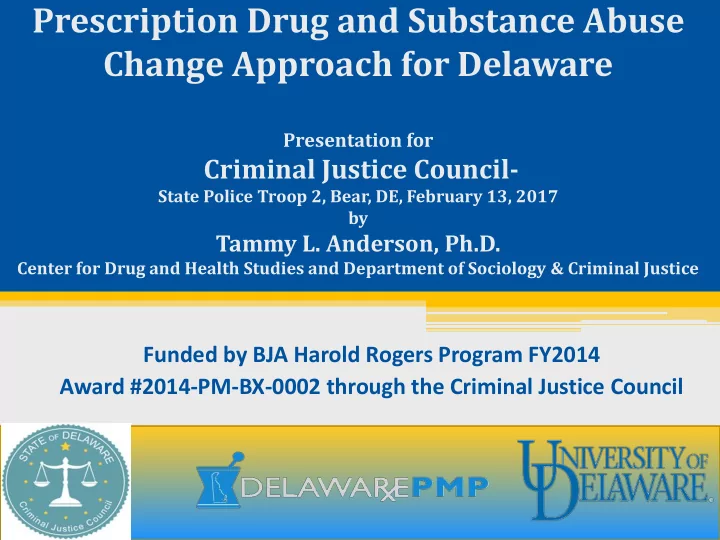

Prescription Drug and Substance Abuse Change Approach for Delaware Presentation for Criminal Justice Council- State Police Troop 2, Bear, DE, February 13, 2017 by Tammy L. Anderson, Ph.D. Center for Drug and Health Studies and Department of Sociology & Criminal Justice Funded by BJA Harold Rogers Program FY2014 Award #2014-PM-BX-0002 through the Criminal Justice Council
Research Project Questions • How are prescription drug (Rx) patterns related to neighborhood demographics, disadvantage, health, crime and disorder? • How is prescription drug use patterned across neighborhoods and communities in Delaware? • How can merged data be used to inform policies and best practices? • How can first responders, law enforcement and community members help us interpret the results so we can improve the use of the findings?
Goals, Strategies, and Activities • Geocode address data in Delaware PMP to Census Tract (advantage over Zip Code geocodes) ▫ Reorganize individual records ▫ 140,000 (approximate) monthly prescriptions ▫ PMP data to date best from January 2013 – March 2015 ▫ Recently received 6 quarters of data (April 1, 2015 – September 30, 2016) • Merge PMP data with external data: ▫ Neighborhood demographics (U.S. Census Data 2010, and American Community Survey 2012) ▫ Crime – arrests and offenses-- data (DELJIS) ▫ Health data (DFS Overdose deaths and toxicology reports)
Geocoding and Census Tracts • Geocoding – coding the Earth by providing geographic reference information that can be used for computer mapping. • Census Tracts – small, neighborhood level subdivisions measured in each decennial census. ▫ Smaller than zip codes* (i.e., 214 versus 68 in DE) ▫ Census Tracts: contain 2,500 – 8,000 people. *Zip codes were developed by the Postal Service for the purpose of delivering mail, but were never intended to define coherent neighborhoods. In addition, Zip Codes can have as many as 10 distinctly different census tracts contained within them. When distinct census tracts are blended together in a single Zip Code, the data reflects their average conditions and often gives a false sense of the area.
Between 2013 and the 1 st quarter of 2015, Delaware neighborhoods averaged 2,113.8 opiate prescriptions per 1,000 residents. These opiate prescription rates were not evenly distributed across Delaware’s neighborhoods. The map shows 3% of the neighborhoods – shaded red- where opiate prescription rates were 50% to 300+% larger than the state average.
Between Jan 1, 2013 and the March 31, 2015, Delaware neighborhoods averaged 70.8 fentanyl prescriptions per 1,000 residents. These fentanyl prescription rates were not evenly distributed across Delaware’s neighborhoods. The map shows 2% of the neighborhoods – shaded red- where fentanyl prescription rates were 100+ % larger than the state average.
Between 2013 and 1 st quarter of 2015, Delaware neighborhoods averaged opiate Rx Morphine Milligram Equivalents (MMEs) of 53.89. MME averages are uneven across Delaware’s neighborhoods (with no clear regional pattern), the distribution is normal with a modest range of 45.24 – 63.81 . BUT , CDC data showed Delaware 2 nd highest MME averages among select states. 22% of the neighborhoods – shaded red- where MME averages were larger than the state neighborhood average or between 56.4 and 63.81.
Private payment (cash or credit card) for prescriptions can be viewed as an indicator of doctor shopping. Between 2013 and March 31, 2015, an average of 209 prescriptions per 1,000 neighborhood residents were paid for privately, i.e., not by insurance. The map shows private pay rates uneven across the state, with 13% (red shaded tracts) reporting 2 standard deviations greater than the average.
Drug overdose deaths vary by neighborhood across the state. New Castle County neighborhoods report significantly more deaths than neighborhoods in Kent or Sussex Counties. This holds up when we adjust for population size. NOTE: The map and distribution for 2015 alone has a similar pattern.
The 2013-2015 neighborhood average # of overdose deaths per 1,000 residents in Delaware is less than 1 (.7). However, a few neighborhoods (about 1%) – shaded red – had an overdose death rate 4 times the state average. The map, and our analyses show, the highest death rates are in New Castle County.
Relationships: Opiate Rx, SES, & Overdose Deaths (Jan 2013 – March 2015) • Table 2 (shown) earlier indicates the top ten (highest) tracks on selected indicators. • The color coding provides some support of a relationship between opiate Rx rates, private payment and overdose deaths, several tracts with high opiate Rx rates are also high in overdoses. There is also a SES relationship with opiates but it differs by population subgroup (separate analysis ongoing now by UD). • However, more sophisticated analyses with the larger data set now available are required since the pattern is uneven.
Violation of probation dominates but data need further coding. 3:1 Male to Female arrests. Reflects illegal drug rates and OD rates but not Rx drug rates. Blacks over-represented compared DE population and all DE opiate indicators. Age-Crime distribution flatter than expected. More arrests (than expected) at older age groups. Top zip code locations for arrests in NCC and SCC, with some correspondence to Rx opiate rates. Preliminary!
Contact Information Tammy L. Anderson, Steve Martin, Yiqian Fang, Jiamin Li, and Guanwen Qi Center for Drug and Health Studies University of Delaware Newark, DE 19716 (302) 831-2291- Office (302) 831-2607- Fax tammya@udel.edu
Recommend
More recommend